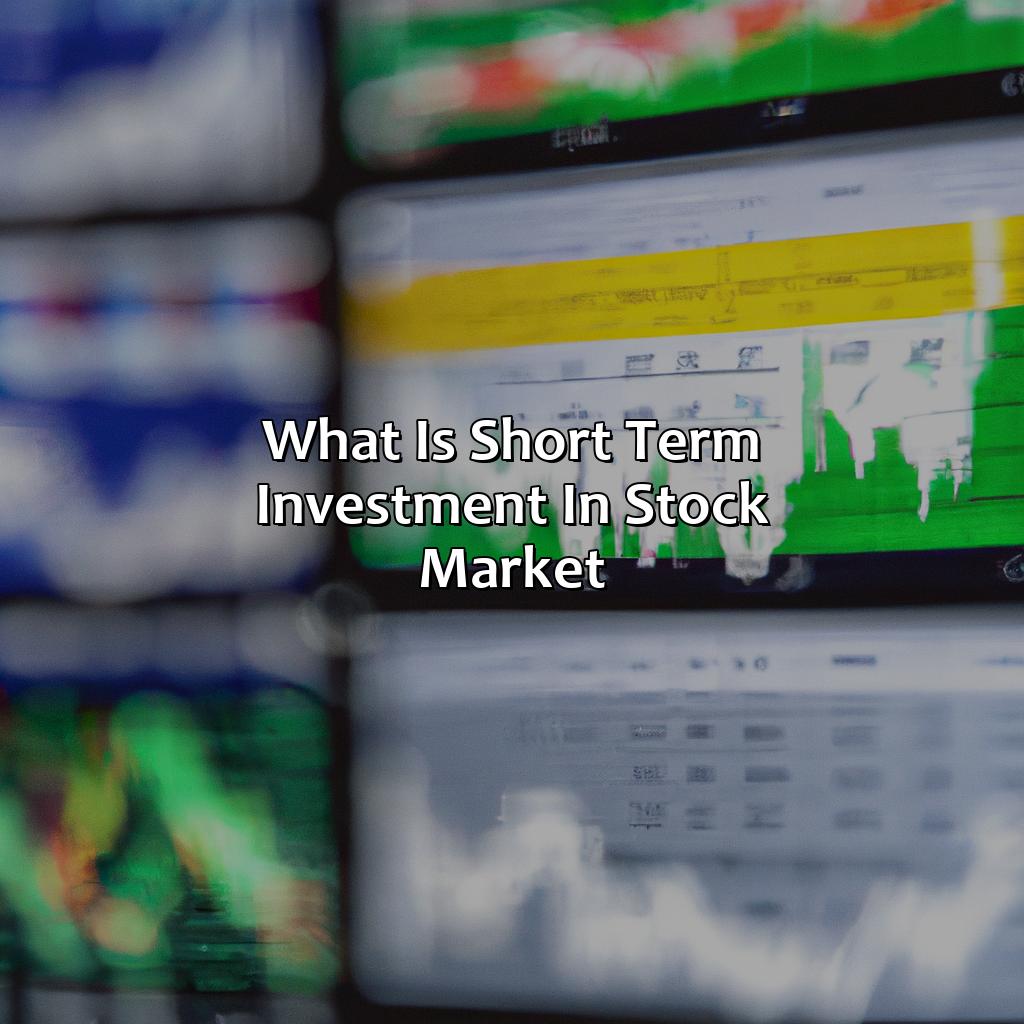What Is Short Term Investment In Stock Market?
Key Takeaway:
- Short term investment in the stock market are investments that typically last less than one year. They can be an effective way to increase returns on investment in a short period of time.
- The types of short term investments in the stock market include stocks, bonds, exchange traded fund (ETFs) and money market funds. Choosing the right type of investment depends on your risk appetite, financial needs and investment goals.
- Before making short term investments, it is important to consider factors like the risk and return, liquidity and access to funds, and market trends and economic indicators. This will help in making informed investment decisions and maximize potential returns.
Do you want to maximize your investments and enjoy good returns? Learn all about short term investment in stock market and maximize your earnings. Investing in stock market can be a smart move; however, understanding the basics is essential for success.
Short term investment: Definition and Importance
Short-term stock market investment refers to buying and selling securities within a short period, often less than a year. It’s popular among investors who want to get quick returns and don’t want to tie up their funds for an extended period. Importance lies in avoiding market downturns. It is important to note that short-term investment is not suitable for everyone, as it involves higher risk and requires more active involvement.
Investors use short-term investment strategies to make quick profits by capitalizing on market fluctuations. These strategies include day trading, momentum trading, swing trading, and scalping. It’s crucial to have a well-defined plan and risk management strategy in place before investing. Short-term investments require active monitoring and market analysis, and it’s crucial to stay up-to-date with industry news and changes in market trends.
Notably, short-term investments provide a higher degree of liquidity, allowing investors to convert their investments into cash quickly. However, this involves higher fees and commissions, which can eat into profits. Additionally, short-term investments are subject to more significant tax liabilities, as they are taxed at a higher rate than long-term investments.
According to Investopedia, more than 75% of day traders lose money. Therefore, investors should carefully assess their risk tolerance and market knowledge before engaging in short-term stock market investment.
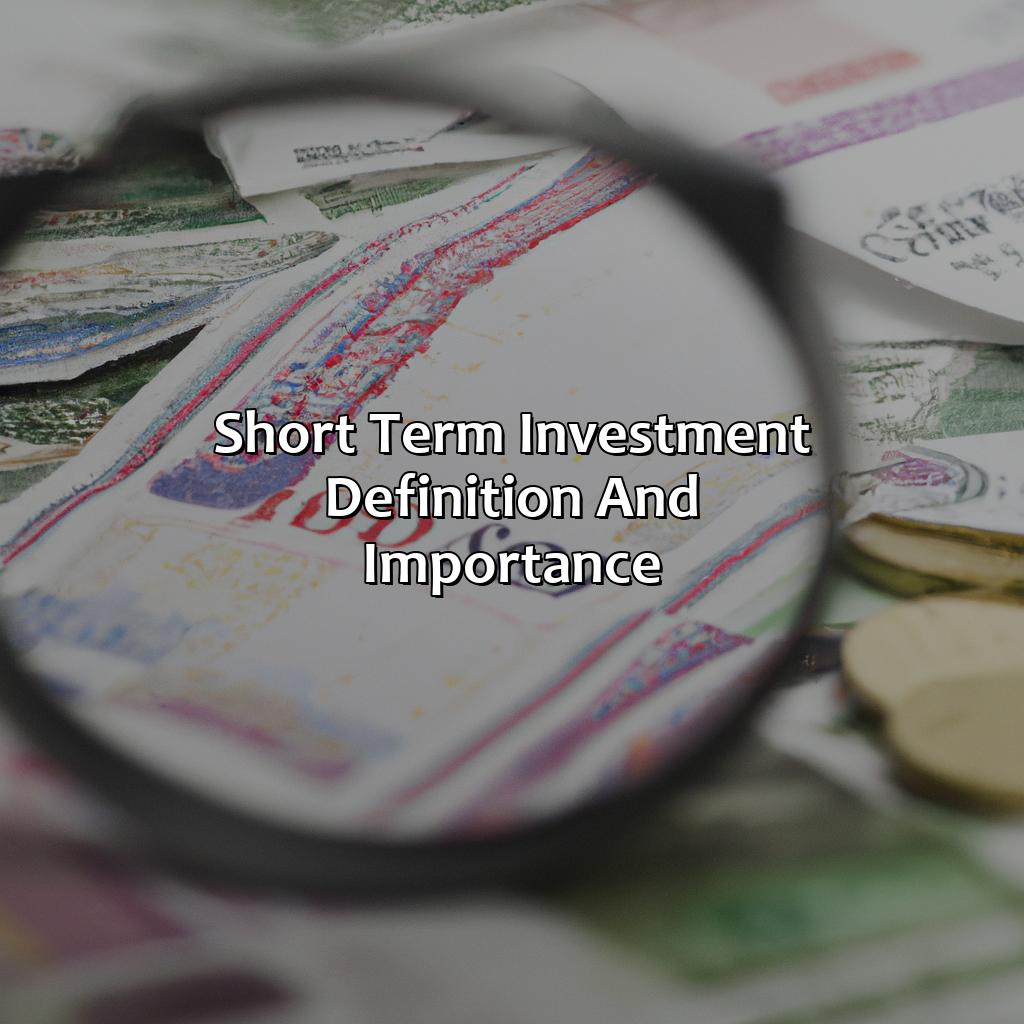
Image credits: retiregenz.com by Yuval Duncun
Types of short term investments in the stock market
Learning about short-term investments in the stock market? Explore the types: Stocks, Bonds, Exchange Traded Funds (ETFs) and Money Market Funds. Get a detailed overview and the info to pick the best option. Make informed decisions!
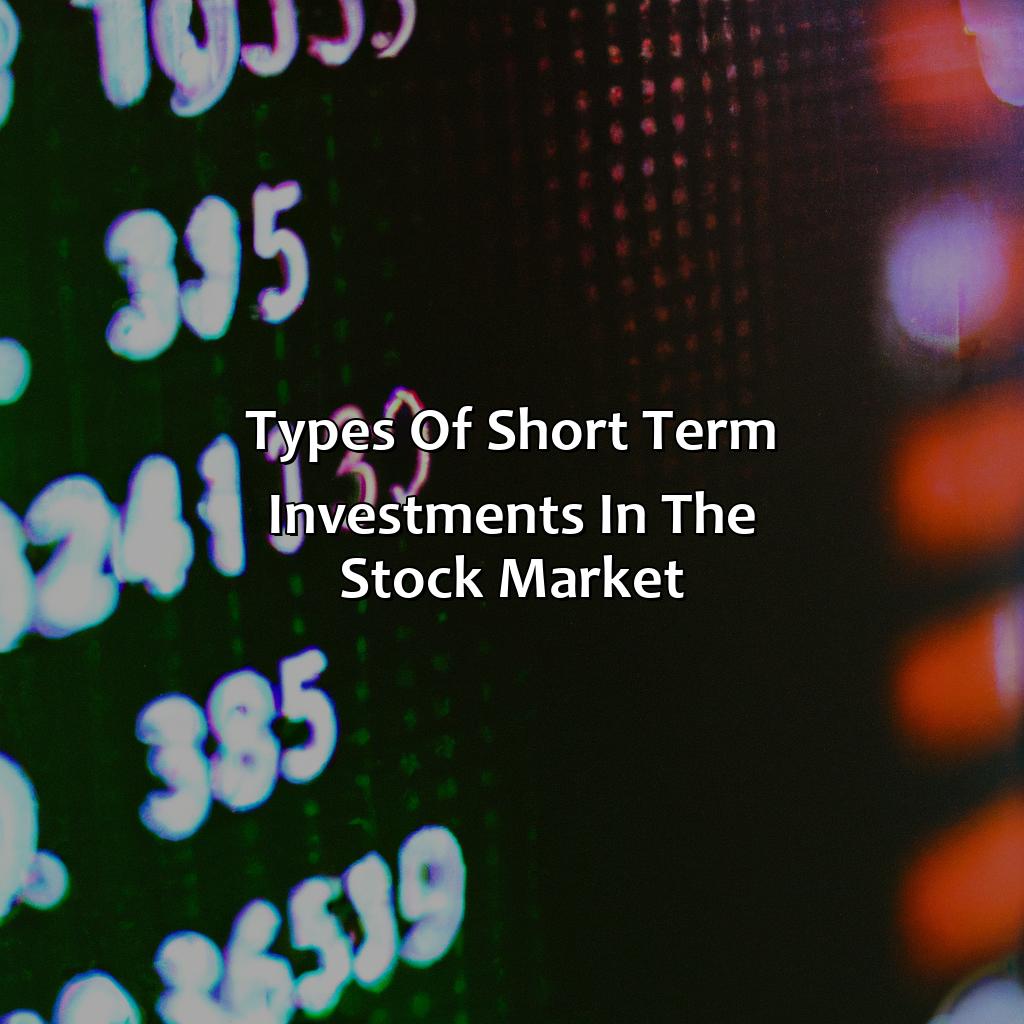
Image credits: retiregenz.com by Adam Woodhock
Stocks
As we delve into the investment world, one of the most lucrative and sought-after markets is Stocks or Equities. It is a unit of ownership in an organization/corporation, which is sold to raise capital by the company. The shareholder buys or sells stocks to profit from market fluctuations or company growth, respectively.
In today’s digital age, investments in stocks have become accessible to the masses with just a few clicks. Stocks provide investors with various benefits like flexibility, liquidity, and high potential returns. Below is a table showing some different types of stocks an investor can buy:
| Type | Explanation |
|---|---|
| Blue chip | Stock of well-established multinational corporations with stable earnings |
| Growth | Stock on fast-growing market segments with high potential but risky |
| Value | Stock of companies undervalued by the market but possess excellent financial records |
| Income-oriented | Preferred shares that pay out a fixed dividend making them ideal for generating income |
Investors can choose from these types based on their objectives and risk appetite.
It’s wise to research before investing as not all stocks are suitable for everyone. An informed investor considers factors like market volatility, historical data, industry trends, and performance record.
Did you know that stock trading arose in the 16th century through merchants who traded their goods but wanted to protect themselves against risks? Together, they created ‘stock’ – certificates representing joint ownership in two or three ships intending to limit losses due to sinking or piracy. Fun fact!
Looking to bond with your money? Better stick to bonds, the perfect short-term investment for those who don’t want to get too attached.
Bonds
Investing in Fixed Income Instruments on the Stock Market
Fixed income instruments or bonds, are a popular short-term investment choice for many investors in the stock market. Bonds provide an opportunity to earn a stable income with minimal risk involved. This makes them a preferred investment option for those looking to diversify their portfolio, especially during times of market volatility.
Bonds come in different forms, including government bonds, corporate bonds, and municipal bonds. Government bonds are issued by national governments and are considered one of the safest investments due to the low risk of default. Corporate bonds are issued by companies and offer higher returns but also have a higher risk of default. Municipal bonds are issued by state and local governments and provide tax-free income.
When investing in bonds, investors should consider several factors such as credit rating, interest rate, maturity date, and yield to maturity. These factors will affect the overall performance of the bond over time and its suitability as an investment choice.
According to Investopedia, as of May 2021, the average yield on a 10-year Treasury bond was around 1.7% whereas some longer-term municipal bonds offered yields upwards of 3%.
ETFs: Because sometimes you just want to invest in a diversified basket of stocks without having to do the math yourself.
Exchange Traded Funds (ETFs)
Investing in a diversified portfolio of assets such as ‘Baskets of Stocks’ or ‘Mixed Asset Funds’ can be achieved through Exchange Traded Funds (ETFs). ETFs are traded on the stock exchange like individual stocks and provide a low-cost alternative to traditional mutual funds. Investors can choose from different types of ETFs such as Equity, Fixed Income, Commodity, Currency or Alternative Investment ETFs.
ETFs generally have a very low management fee and offer transparency on underlying holdings in terms of daily purchases and redemptions. These fund structures offer potentially higher returns than traditional savings accounts but with minimal risk due to diversification across various asset classes. Passive investment strategies using ETFs mimic benchmark indices (index funds) whereas Active management is also available. Some ETFs also offer dividend distributions for investors to participate in market gains.
A variety of providers exist for Exchange Traded Funds offering advice, research and access to global markets at a low cost with total expense ratios (TER) often lower than Mutual Funds. Investing in an ETF offers the same tax benefits as shares do, enabling investors to offset capital losses against taxes payable on any gains they may make.
Exchange Traded Funds are versatile with high liquidity designed for short-term trading goals although they may also serve longer-term strategies by investing systematically without approaching market timing decisions.
Investor experience tells that investing in Banking sector focused ETFs yield better results than depositing directly into bank accounts yielding comparatively lower returns. Similarly Capitlization-Weighted Equity Indexes like S&P 500 demonstrates well diversified investment approach lowering risks involved while providing higher reward potential over time. Ultimately, being disciplined while investing using Dollar-Cost Averaging method will drive long-term profits whereby regular investments are made into multiple stocks taking advantage of volatility over extended periods leading to dollar-cost averaging advantages.
Looking for a fling with your money? Money market funds are the ultimate short term investment partners.
Money Market Funds
For investors who need a safe and low-risk alternative to traditional stocks, cash-equivalent investments like ‘Short-term treasuries’ are the most common choice. Another popular type of cash-equivalent investment is ‘Money Market Funds.’ They are a diverse set of short-term fixed-income securities that one can buy in the open market. The fund is managed by experts to provide capital preservation and minimal risk. The fund invests in highly-rated federal bonds, municipal bonds and commercial papers issued by reliable companies with high credit ratings.
Unlike other stock market investments, money market funds generally aim to maintain a Net Asset Value (NAV) of $1 per share. Furthermore, there is no guarantee that an investor’s money will achieve this objective, especially during times of financial crisis or illiquid markets.
Pro tip: For those looking for low-risk options among the stock market investments, Money Market Funds can be a worthy pick. They offer decent returns over time while keeping your finances secure as they traditionally come with low expense ratios. Before making that short term investment, remember: the only thing shorter than the investment is your attention span.
Factors to consider before making short term investments
For confident short-term investments, several key factors should be kept in mind. To protect your stock market investment, three areas need focus: risk & return, liquidity & access to funds, and market trends & economic indicators.
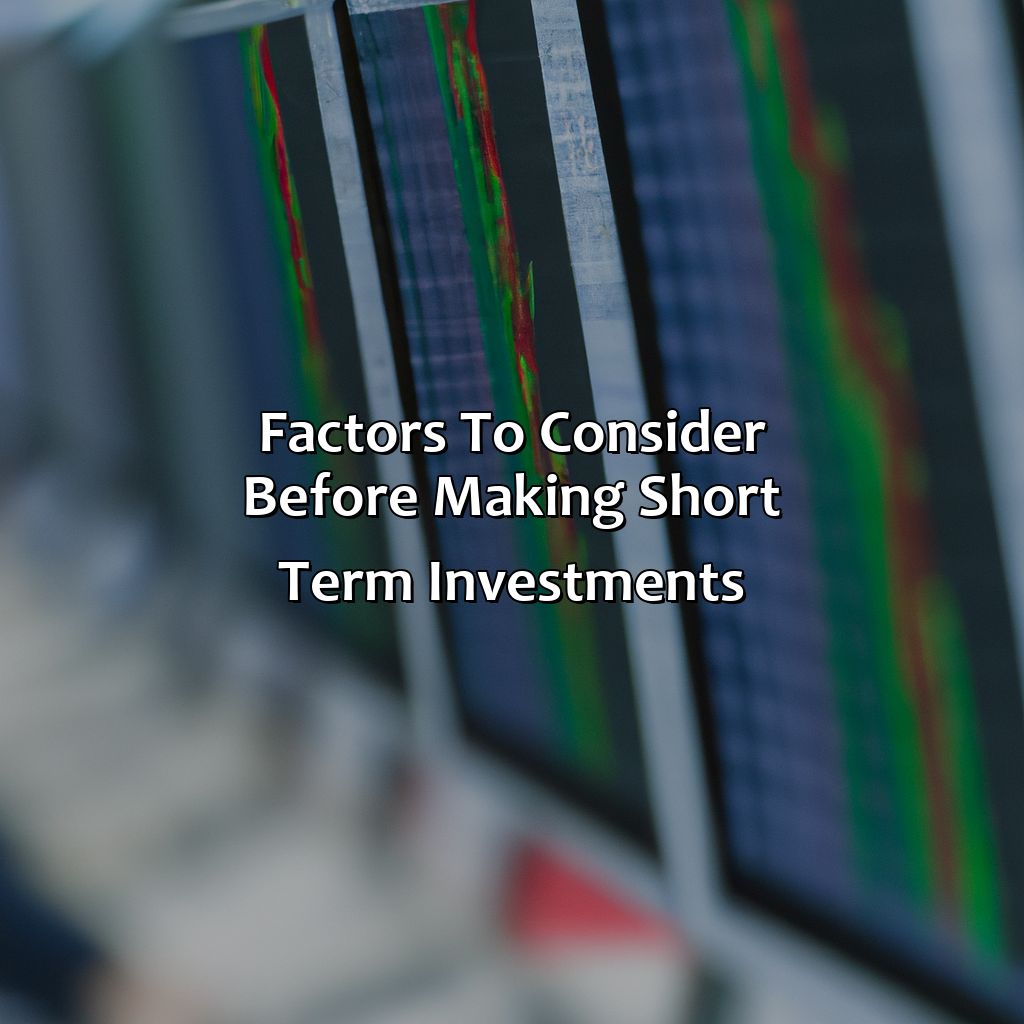
Image credits: retiregenz.com by James Jones
Risk and return
Short term investments in the stock market involve a balance between risk and return. The higher the risk, the higher the potential return. It is crucial to consider both factors before making any investment decisions.
Investors should allocate their assets based on their risk tolerance and investment objectives. Low-risk investments like bonds offer stability but low returns, while high-risk investments like stocks can provide significant returns but also come with a higher risk of losing money.
One way to mitigate risks is diversification – investing in a variety of assets spread across different industries and countries. This strategy helps investors to reduce exposure to any single asset or market.
Pro Tip: Before making any short-term investments, investors should do thorough research and analysis of the company’s financial performance and market trends. Only invest what you can afford to lose.
With short term investments, it’s important to have access to your funds at a moment’s notice, but don’t worry – you won’t need a magician to make them appear.
Liquidity and access to funds
Short-term investments must be liquid and accessible. As one of the critical considerations, investors should prioritize having funds readily available for any unforeseen circumstances. Before investing, examine the liquidity ratio and trading volume of stocks or securities. The frequency of buying and selling also determines how quickly investments can be turned into cash.
Apart from liquidity, access to funds is another crucial factor. As an investor, it’s essential to have access to funds when needed without incurring penalties or withdrawal charges. Taking into account emergency funds and other daily expenses is vital before investing in short-term securities, as these could help prevent financial difficulties.
Short-term investments require careful consideration when determining their suitability. An intelligent investment strategy that accounts for liquidity and accessibility of funds will provide flexibility in times of need while ensuring that principal investment is not compromised.
Pro Tip: Regular reviews of your portfolio balance ensure that you maintain your desired allocation for short term investments while adjusting asset classes and risk level according to market changes.
Don’t trust the market trends, they change faster than a toddler’s mood.
Market trends and economic indicators
Analyzing the current Market Position and Economic indications is crucial while making Short Term Investments in the Stock Market. Here are some essential factors to consider:
Market Trends and Economic Indicators
| Factor | Description |
| Inflation Rate | Rising prices shrink purchasing power, leading to lower demand for stocks. |
| Interest Rates | Higher Interest rates increase borrowing cost and affect company profits. |
| Gross Domestic Product(GDP) | A declining GDP indicates a struggling market while increasing GDP indicates market growth. |
It’s important to look into other factors like government policies, global events, and seasonality effect on the stock market.
Pro Tip: Short term investments require precise analysis of Market Trends and Economic Indicators. Keep a regular check on the volatile nature of the stock market.
Remember, in short term investing, always buy low and sell high or else you’ll end up with more losses than a toddler playing Jenga.
Strategies for successful short term investing
For short-term investing success, diversification, portfolio monitoring, and market timing are key. Diversify to spread risks and reduce losses. Monitor your portfolio to stay informed of trends and adjust investments. Market timing needs a good grasp of trends and willingness to take risks – calculated ones.
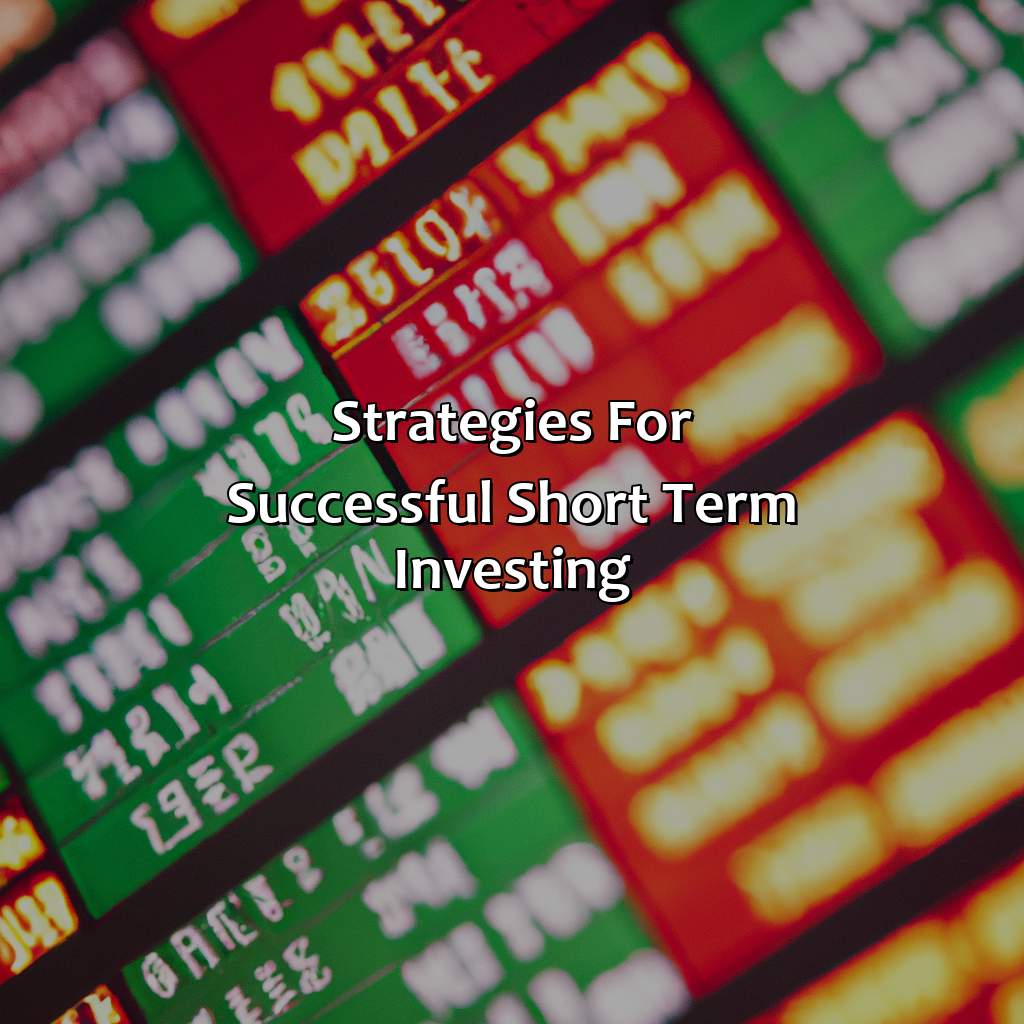
Image credits: retiregenz.com by David Arnold
Diversification
A vital aspect of successful short-term investment is proper portfolio diversification. By investing smartly, traders can mitigate unfavorable risks and spread their investments across multiple stocks or assets. This approach reduces the risk of losing all funds due to a poorly-performing investment.
Diversifying across sectors and industries allows investors to avoid significant losses in any specific asset and leverage potentially profitable locations. A well-diversified portfolio should contain a mix of high- and low-risk assets from different sectors that inspire confidence without being overly risky. Incorporating assets with low correlation coefficients can add value, as it helps reduce portfolio risk by decreasing the impact of major market movements on individual securities. Including alternative investments like real estate, commodities, or mutual funds can also provide additional investment opportunities.
Pro Tip: Ensure your portfolio remains balanced by regularly monitoring investments and updating your strategy as conditions change. By staying vigilant, you proactively safeguard against potential negative effects, preventing significant losses.
Keeping an eye on your portfolio is like keeping an eye on your ex, you don’t want to obsess over it, but you also don’t want to miss any red flags.
Monitoring your portfolio
Monitoring the Performance of Your Investment Portfolio
An essential aspect of short-term investing is Monitoring the performance of your investment portfolio. It is crucial to track your investments regularly to ensure that they remain profitable and aligned with your investment goals.
- Assess your portfolio’s current financial health to identify the necessary adjustments or changes.
- Keep a close eye on market trends and industry news that may affect your investments in the short term.
- Stay up-to-date with the latest stock prices and market index movements that could indicate significant changes in stock valuations.
- Look beyond stocks and consider diversifying into other investment vehicles, such as bonds or exchange-traded funds (ETFs).
- Review your portfolio allocation regularly, ensuring that you maintain a diversified portfolio with stocks across different industries and markets.
- Avoid making impulsive decisions based on sudden market movements; instead, stay true to your investment strategy and risk tolerance.
It is useful to monitor your portfolio by setting up alerts or notifications for significant events such as earnings reports or price movements beyond predefined thresholds. This way, you receive timely updates and can make informed decisions regarding when to buy or sell.
Pro tip: Set up a tracking system for monitoring your portfolio performance. Regularly review these metrics against benchmark indices for better insights into how well you are performing compared to the broader market. Don’t try to time the market, unless you have a time machine and a crystal ball.
Timing the market
Short-Term Investment: Maximizing Market Timing
Optimizing the timing of market entry and exit is critical when seeking to maximize short-term investment returns. To optimize market timing, investors must familiarize themselves with the market’s historical trends and cycles, analyze macroeconomic indicators, watch for company-specific news and events, monitor insider trading activities, and implement sophisticated analytical techniques.
By conducting thorough market research, investors can identify stocks that are primed for short-term gains. Additionally, they may leverage advanced trading algorithms to automate their purchase and selling decisions based on expertly calculated technical indicators.
To add further depth to this strategy, investors may also consider implementing a stop-loss order mechanism that automatically executes the sale of leveraged positions if asset values fall below predetermined levels.
By employing these strategies in combination, investors can significantly enhance their odds of realizing profits from short-term equity investments.
Some Facts About Short Term Investment in Stock Market:
Short term investment in stock market refers to investing in stocks with a holding period of less than one year. (Source: The Balance)
Short term investments are generally considered to be riskier than long term investments. (Source: NerdWallet)
Short term investment strategies include day trading, swing trading, and momentum trading. (Source: Investopedia)
Short term investments are often made based on technical analysis of stock charts and patterns. (Source: Forbes)
Short term investments can provide quick profits, but also require active monitoring and a high level of market knowledge. (Source: The Motley Fool)
FAQs about What Is Short Term Investment In Stock Market?
What is short term investment in stock market?
Short term investment in stock market refers to buying and selling stocks within a short period of time, usually within a few weeks or months. The goal of short term investment is to make quick profits by taking advantage of price fluctuations.
What are some examples of short term investments in the stock market?
Some examples of short term investments in the stock market include day trading, swing trading, and scalping. Day trading involves buying and selling stocks within the same trading day, while swing trading involves holding stocks for a few days to a few weeks. Scalping involves making multiple trades within a short period of time to capitalize on small price movements.
What are the risks involved in short term investment in stock market?
Short term investment in stock market can be risky due to the high volatility of the stock market. Prices can fluctuate rapidly, and there is no guarantee of making a profit. Additionally, short term investment requires a lot of knowledge, skill, and experience which many beginners may not have.
What are the advantages of short term investment in stock market?
One advantage of short term investment in stock market is the potential to make quick profits. Another advantage is the ability to take advantage of market trends and news events to capitalize on price movements. Short term investment also provides more flexibility and control, since investors can quickly adjust their positions based on changing market conditions.
What are the best stocks for short term investment?
The best stocks for short term investment are those that are highly volatile and have significant price movements. These are typically stocks of companies that are experiencing major changes, such as a new product launch, a merger or acquisition, or a change in leadership. However, it is important to conduct thorough research and analysis before making any investment decisions.
What is the best strategy for short term investment in stock market?
The best strategy for short term investment in stock market depends on various factors, including the investor’s risk appetite, investment goals, and available resources. However, some common strategies include technical analysis, fundamental analysis, and using stop-loss orders to limit losses. It is important to develop a solid strategy based on one’s own investment profile and stick to it to maximize profits.
 Checkout this IRS Loophole
Checkout this IRS Loophole 
